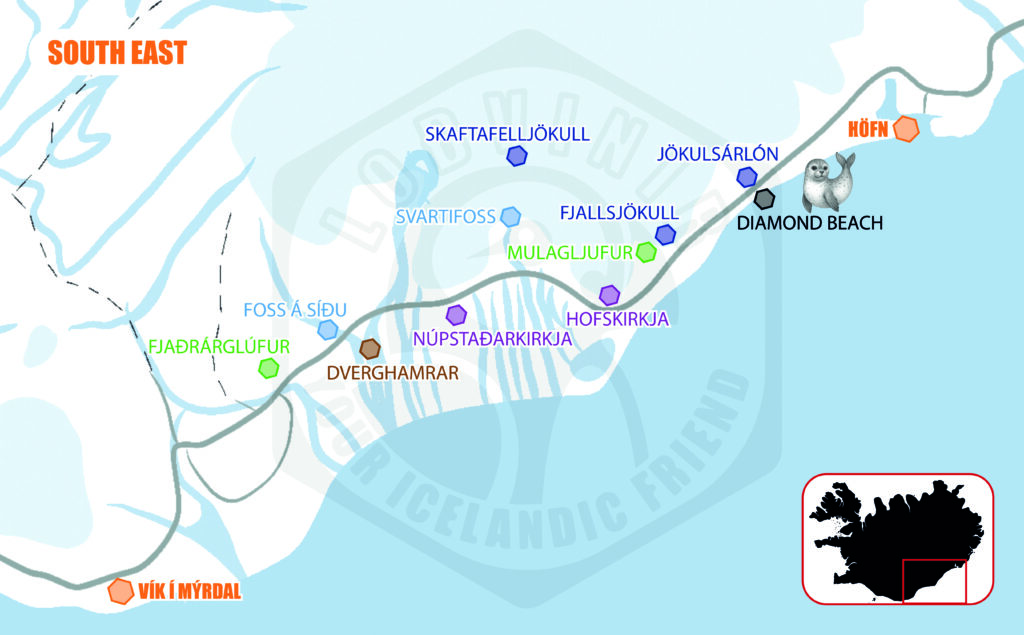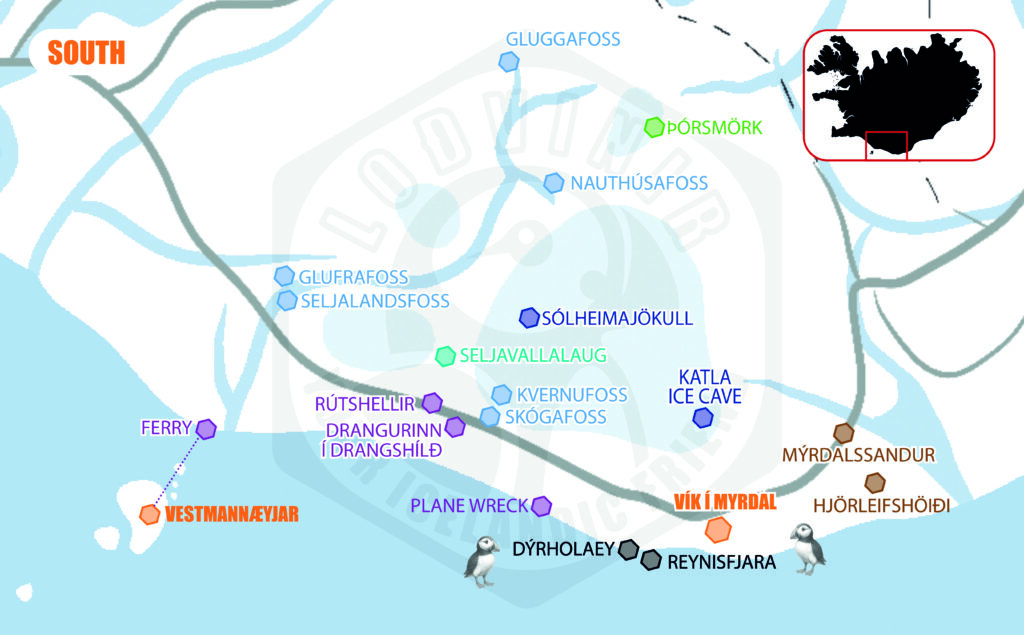
Ready to explore Iceland?
In this guide, we’ll take you through the best spots around Reykjavík, the Golden Circle, and the Reykjanes Peninsula. Whether you’re chasing waterfalls, volcanoes, or hidden hot springs, this is your ultimate resource to plan the perfect route.
⚠️ Important Note Before You Plan Your Route…. (Click Here)
We recommend reading our general travel guidelines before organizing your itinerary around Iceland. The weather here is unpredictable and can change rapidly, especially in winter. Some roads — even those that seem accessible on the map — may become difficult or even impassable depending on the season and conditions.
It’s also impossible to see everything in one trip, so we suggest selecting your top priorities based on the time you have available, your fitness level, and road safety updates.
Don’t underestimate driving distances either — even short routes can take longer due to road conditions, photo stops, and the sheer beauty that will tempt you to stop often!
Important to check weather and road conditions at Vedur.is, Road.is or SafeTravel.is
Check our Travel Guide to Iceland – Essential Tips for a Perfect Trip
REYKJANES PENINSULA, REYKJAVIK AREA AND THE GOLDEN CIRCLE
What to do in Reykjanes Peninsula, Reykjavik Area and The Golden Circle?
REYKJANES PENINSULA
Let’s be honest — most visitors don’t explore the Reykjanes Peninsula beyond the Blue Lagoon or during the hype of recent volcanic eruptions when the area briefly stole the spotlight.
Chances are, you’ll drive straight through without stopping — but if you’ve got extra time after or before your flight, or if you’re just curious about Iceland’s raw volcanic nature, this region is worth a quick detour.
The Reykjanes Peninsula offers a stark, almost otherworldly landscape shaped by the Mid-Atlantic Ridge, where the North American and Eurasian tectonic plates slowly drift apart. Expect dramatic fissures, steaming geothermal spots, and endless moss-covered lava fields — the perfect backdrop if you want to feel like you’ve landed on another planet.
📍KEFLAVIK AIRPORT ✈️
Keflavík International Airport is Iceland’s largest airport and the main entry point for international travelers.
- 45 min drive from Reykjavik. Route 41.
- Curiosities: Originally built by the US military in 1943 during World War II. It remained a strategic NATO base until the early 2000s.
- Tips: Take advantage of the duty-free prices, especially for alcohol, as it’s much cheaper than in the country. But be careful, there is a limit of what you can bring with you.
📍BRIDGE BETWEEN CONTINENTS 🏘️
A symbolic footbridge spanning the gap between the North American and Eurasian tectonic plates, where visitors can literally walk from one continent to another.
- The bridge was built in 2002 to highlight the Mid-Atlantic Ridge’s presence on land. Iceland is one of the few places on Earth where this ridge is visible above sea level.
- Minim Visit Duration: 15 min
- Difficulty level: Very easy. Short walk from the parking area; the bridge and paths are accessible.
- Curiosities:
- The plates here drift apart by about 2.5 cm per year.
📍BRIMKETILL – LAVA ROCK POOL 🖤
Brimketill is a natural lava rock pool carved by the Atlantic waves, sitting right on the edge of a rugged cliff. It looks like a small, rocky basin where the ocean violently crashes in.
- DO NOT ATTEMP TO SWIM OR ENTER THE POOL!
- Leyend: According to folklore, Brimketill was the bathing pool of a troll woman named Oddný. She was said to use the pool at night, adding a mythical charm to the wild setting.
- Minim Visit Duration: 15 – 20 min
- Difficulty level: Very easy. The viewing platform is just a short walk from the parking area.
- Curiosities: The name Brimketill roughly means “surf cauldron”.
📍RECENT VOLCANO ERUPTIONS NEAR GRINDAVÍK 🌋
At the moment, there are no ongoing eruptions in Iceland, but several volcanoes remain active and closely monitored.
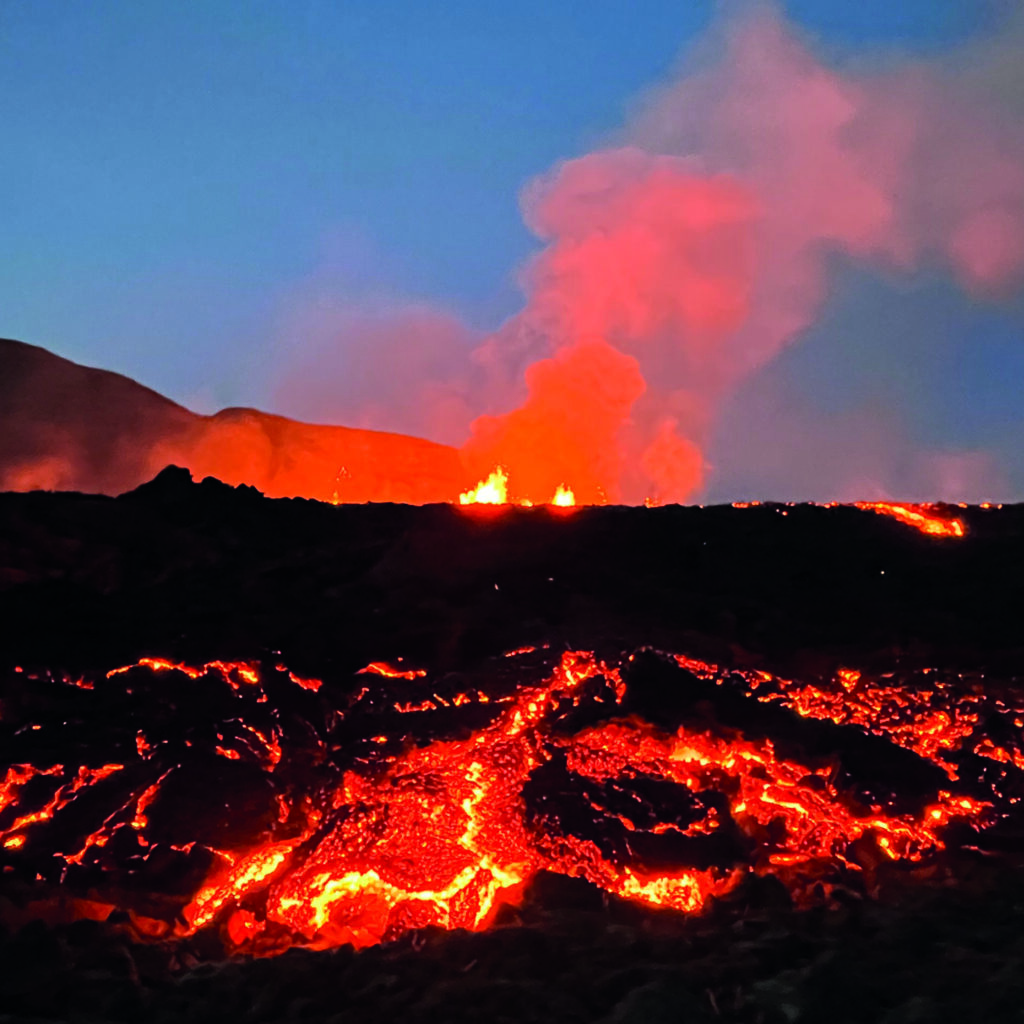
Since 2021, the Reykjanes Peninsula has experienced a series of volcanic eruptions, breaking an 800-year dormancy in the region. The eruptions — including Geldingadalir (2021), Meradalir (2022), Litli-Hrútur (2023), and Sundhnúkagígar (2024-2025) — have drawn worldwide attention with glowing lava flows and accessible eruption sites.
CHECK ALL THE INFORMATION ABOUT THE AREA IN SAFETRAVEL.IS
📍RAUFARHÓLSHELLIR – LAVA TUNNEL 🖤
Raufarhólshellir is one of the largest lava tunnels in Iceland, stretching about 1.3 km (0.8 miles). It was formed during a volcanic eruption around 5,200 years ago, when flowing lava created a massive underground passage.
- Minim Visit Duration: 1-3 h
- Only with a guided tour.
- Difficulty level: Very easy. The viewing platform is just a short walk from the parking area.
- Curiosities:
- The cave was a filming location for the movie Noah (2014) starring Russell Crowe.
REYKJAVIK – The World’s Northernmost Capital
Reykjavík, Iceland’s quirky and colorfull capital, is where most journeys around the island begin or end. Although small by international standards, the city offers a rich blend of culture, modernity, and history, all set against a backdrop of mountains and the Atlantic Ocean.
SOON we will post all information about this city in a new post!
But if you are visiting Reykjavik, it is your opportunity to get the cutest souvenir from Iceland without extra fees or delivery.
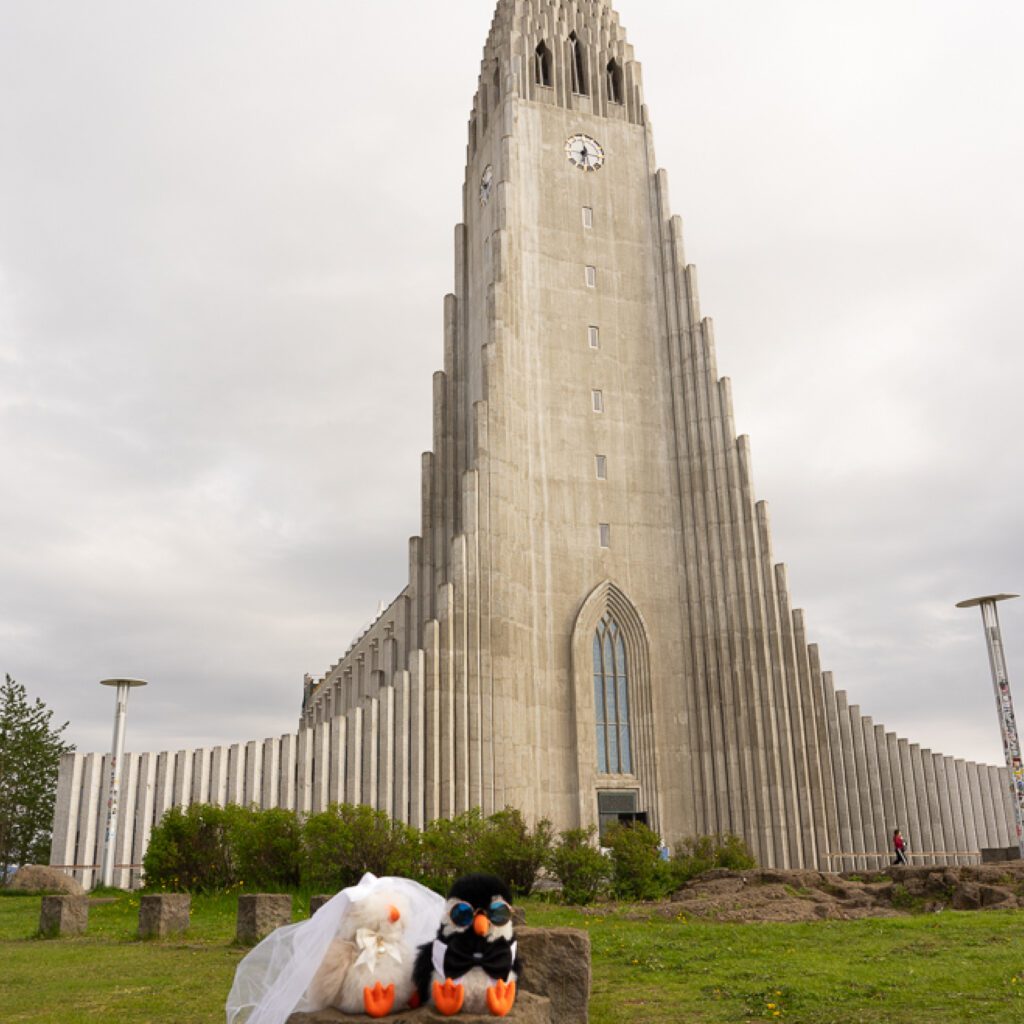
GOLDEN CIRCLE – Iceland’s Iconic Sightseeing Route
The Golden Circle is Iceland’s most famous sightseeing route, easily doable in a day from Reykjavík. It connects three of the country’s most iconic natural landmarks: Þingvellir National Park, the erupting Geysir geothermal area, and the mighty Gullfoss waterfall.
In addition to the Golden Circle “big three,” there are several nearby sites worth visiting, and we’ve included them on our map to help you make the most of your journey — including the volcanic crater Kerið, the picturesque Faxi waterfall, the towns of Selfoss and Hveragerði, and the hot spring valley of Reykjadalur.
These stops add diversity to the route, whether you’re into hiking, relaxing in natural hot springs, or just chasing more waterfalls.
📍 ÞINGVELLIR NATIONAL PARK 🗻🌊
Þingvellir is a UNESCO World Heritage Site famous for its geological and historical significance. Here, you can walk between the North American and Eurasian tectonic plates and visit the birthplace of the world’s first parliament, founded in 930 AD.
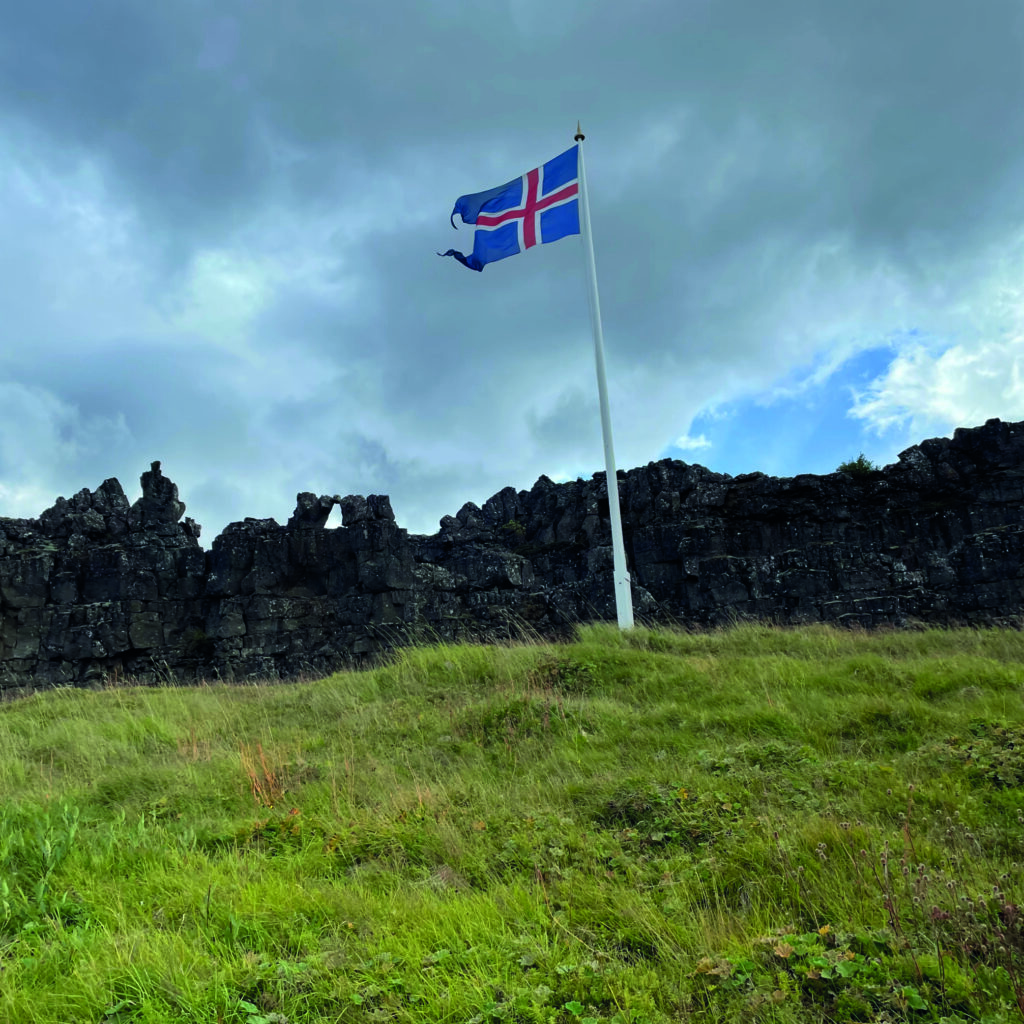
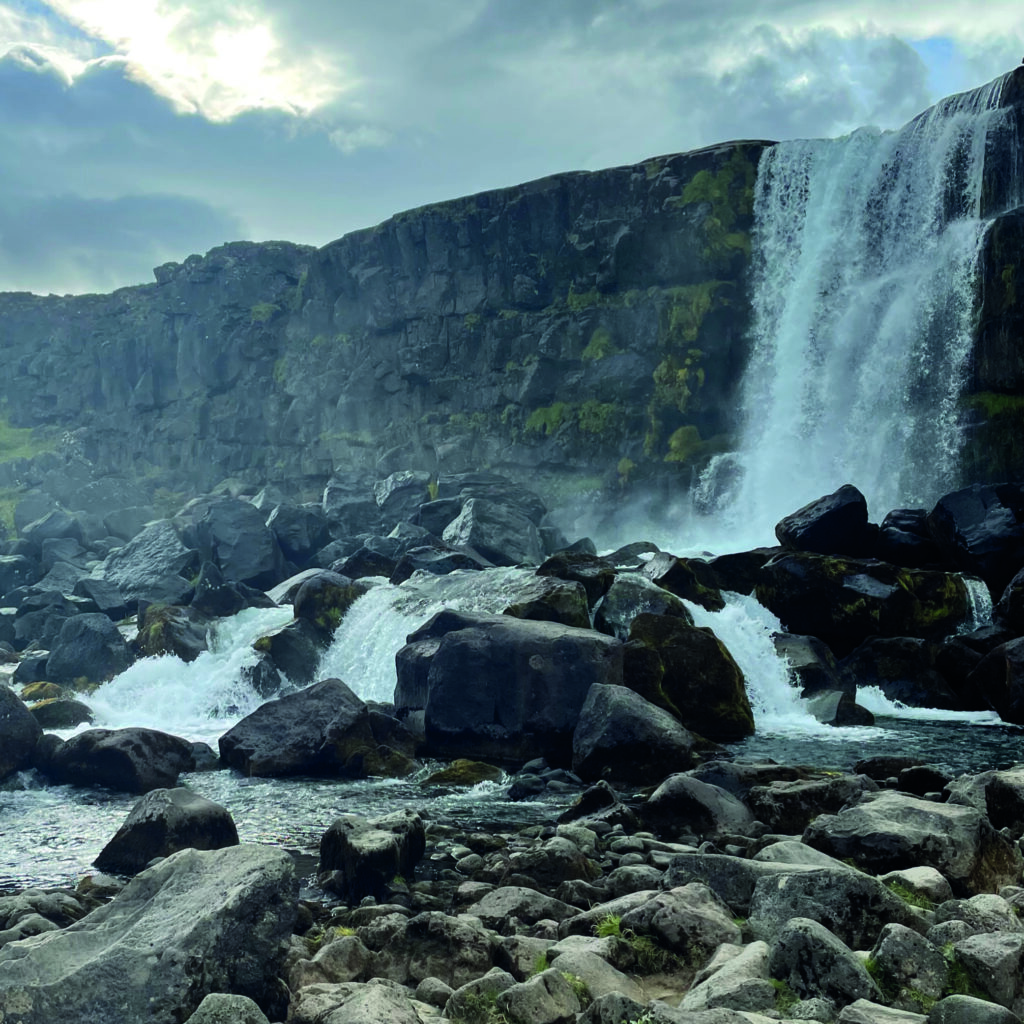
Þingvellir was the site of the Alþingi, where chieftains gathered to make laws and settle disputes in Viking times.
- You can walk between the tectonic plates at Almannagjá gorge, visit the Lögberg (Law Rock) where the parliament convened, see Öxarárfoss waterfall or do Snorkel or dive in Silfra fissure, a crystal-clear underwater rift.
- Minim Visit Duration: 1,5 – 3 h, longer if doing snorkeling or hiking further.
- Difficulty level: Easy. Well-marked paths but some uneven terrain.
- Entry to the park is free, but there is parking with fee. Guided activities like snorkeling are extra.
- Curiosities:
- Þingvellir is literally splitting apart by ~2 cm per year.
- Some scenes from Game of Thrones were filmed here, depicting the path to the Eyrie.
📍LAUGARVATN – VILLAGE 🏘️
Laugarvatn is a small village by a scenic lake, famous for its natural geothermal activity along the shoreline and the Fontana Geothermal Baths spa experience.
- Bathe in the Fontana Spa or the lake behind, this one is partially warm near the shore due to geothermal vents underwater.
- Taste traditional geothermal-baked rye bread.
📍FRIÐHEIMAR GREENHOUSE 🏘️
Friðheimar is a working greenhouse where tomatoes are grown year-round using geothermal energy. It’s also a unique restaurant where you can dine among the tomato plants.
- Eat tomato-based dishes in the greenhouse.
- Join a guided tour to learn about geothermal horticulture.
- Meet the Icelandic horses bred on-site.
📍 GEYSIR GEOTHERMAL AREA 💨
The Geysir geothermal area is home to the world-famous Strokkur geyser, which erupts every 5-10 minutes, shooting boiling water up to 20 meters into the air. The area is a field of steaming vents, bubbling mud pots, and colorful mineral deposits.
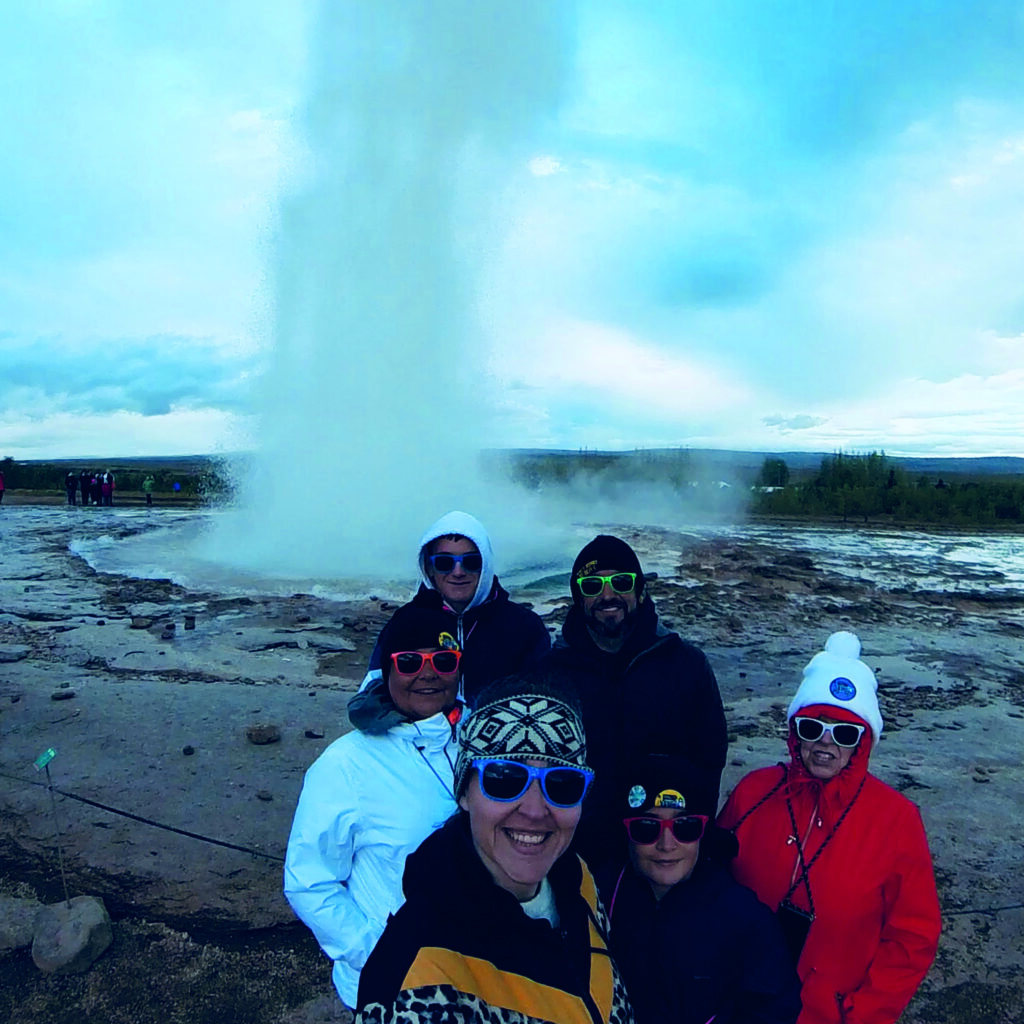
The original Great Geysir, from which all geysers worldwide take their name, was once the tallest, erupting up to 80 meters, but it’s now largely dormant. Strokkur remains the star of the show, consistently active.
- Minim Visit Duration: 30 min.
- Fumaroles, hot springs, and bubbling mud pools (not for bath).
- Difficulty level: Very easy. Flat paths suitable for all ages.
- Free entry. Parking Included.
- Curiosities: The plates here drift apart by about 2.5 cm per year.
📍 GULFOSS WATERFALL 🌊
Gullfoss — meaning Golden Falls — is one of Iceland’s most iconic waterfalls. The Hvítá River plunges into a deep canyon in two dramatic tiers, creating an immense roar and mist that often forms rainbows on sunny days.
- Minim Visit Duration: 30 – 45 min.
- Free but small parking fee.
- Difficulty level: Easy.
- Curiosities:
- In the early 1900s, hydroelectric dam plans were stopped by environmentalist Sigríður Tómasdóttir, thanks to whom the falls remain natural—earning her the title of one of Iceland’s first conservationists.
📍 FAXAFOSS WATERFALL 🌊
Faxafoss, also known simply as Faxi, is a wide, serene waterfall on the Tungufljót River. It’s much smaller than Gullfoss but spreads gracefully across the landscape, often overlooked by tourists rushing to bigger sights.
- You might spot salmon jumping upstream during the right season. It was historically an important spot for fishing.
- Minim Visit Duration: 30 min
- Difficulty level: Very easy.
- Small parking fee.
- Curiosities:
- It was historically an important spot for salmon fishing, a tradition still ongoing.
- Faxi is sometimes called “the little brother of Gullfoss”, but its wide curtain of water has its own charm.
- It’s popular with locals as a picnic and fishing spot.
📍SKÁLHOLT CATHEDRAL 🏘️
Skálholt is one of Iceland’s most important historical sites — the location of the country’s first bishopric and an ancient religious center since the 11th century.
- The current cathedral was built in the 1950s, but the site’s religious importance dates back over 900 years.
📍 KERIÐ CRATER LAKE 🌋
Kerið is a striking, oval-shaped volcanic crater about 3,000 years old, featuring steep red and black slopes and a vivid turquoise lake at the bottom. It’s one of the few recognizable, intact volcanic calderas you can easily walk around — or even descend into.
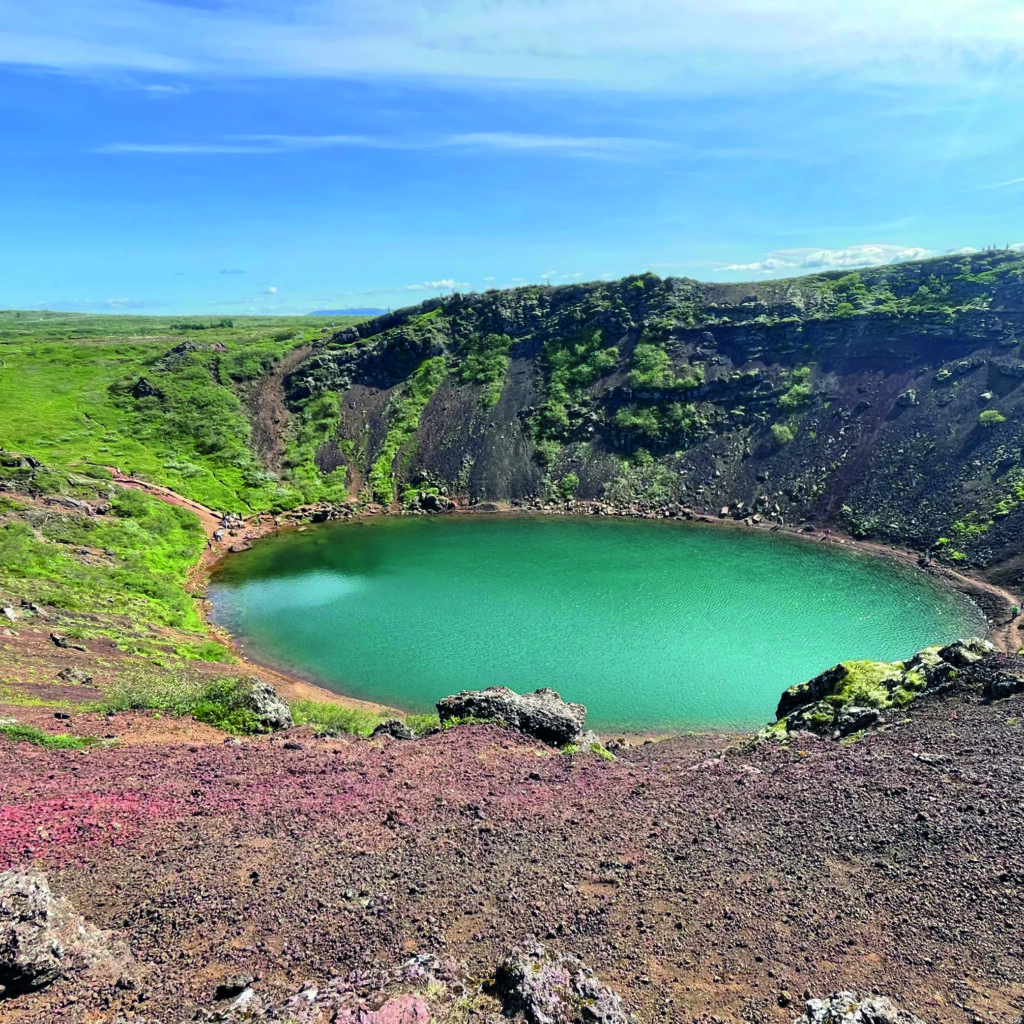
- Kerið was once thought to be formed by a massive volcanic explosion, but scientists now believe it’s a collapsed magma chamber.
- Minim Visit Duration: 30 – 45 min
- Difficulty level: Easy-moderate. Well-maintained paths but a bit steep descending to the lake.
- Small entrance fee.
- The crater is about 55 meters deep, with the lake depth varying seasonally.
📍SELFOSS (TOWN) 🏘️
Selfoss is the largest town in South Iceland, with a population of around 9,000 people. While it may not be a tourist hotspot itself, it’s a practical stop for fuel, groceries, and restaurants when exploring the Golden Circle or heading east along the south coast.
📍HVERAGERÐI – THE GEOTHERMAL TOWN 🏘️💨
Hveragerði is a small town that sits directly on a geothermal hotspot, earning its nickname: “The Hot Spring Town.” As soon as you arrive, you’ll notice steam rising from the ground — not in some distant field, but right between houses, backyards, and greenhouses.
Unlike other places in Iceland where geothermal areas are remote, in Hveragerði the geothermal forces are part of daily life. The town has long embraced this energy, using it to heat homes, power greenhouses, and even cook food underground.
- Geothermal Park (Hveragarðurinn):
- A small but active geothermal field located in the center of town. Visitors can walk safely among boiling mud pots, steaming vents, and colorful mineral deposits. You can even boil an egg in a hot spring or taste hverabrauð, a traditional rye bread slowly baked underground.
- Geothermal Greenhouses:
- Hveragerði is famous for its geothermal horticulture. Local greenhouses grow everything from tropical fruits to flowers, thanks to the natural hot water. Some greenhouses offer visits or cafés where you can enjoy produce grown on site.
- Earthquake Exhibition
- n 2008, a 6.3 magnitude earthquake struck the region, intensifying geothermal activity in the town. The local exhibition shows how earthquakes and geothermal energy shape Iceland’s landscape and daily life.
- Laugaskarð Swimming Pool
- A naturally heated pool surrounded by geothermal vents. A relaxing spot for locals and visitors alike, complete with hot tubs and a sauna.
📍HVERADALIR – GEOTHERMAL AREA 💨
Hveradalir is a highly active geothermal zone within the Reykjadalur Valley, filled with steaming vents, bubbling mud pots, and colorful mineral deposits. The earth here feels alive, raw, and unpredictable.
- Minim Visit Duration: 20 – 30 min
- Difficulty level: Very easy.
- Free entrance, small parking fee.
- Curiosities: “Hveradalir” means “valley of hot springs”
- No bathing here.
📍 REYKJADALUR HOT SPRING RIVER 🛁
Reykjadalur, meaning “Steam Valley”, is famous for its hot spring river where visitors can bathe in warm, naturally heated water in the middle of untouched nature.
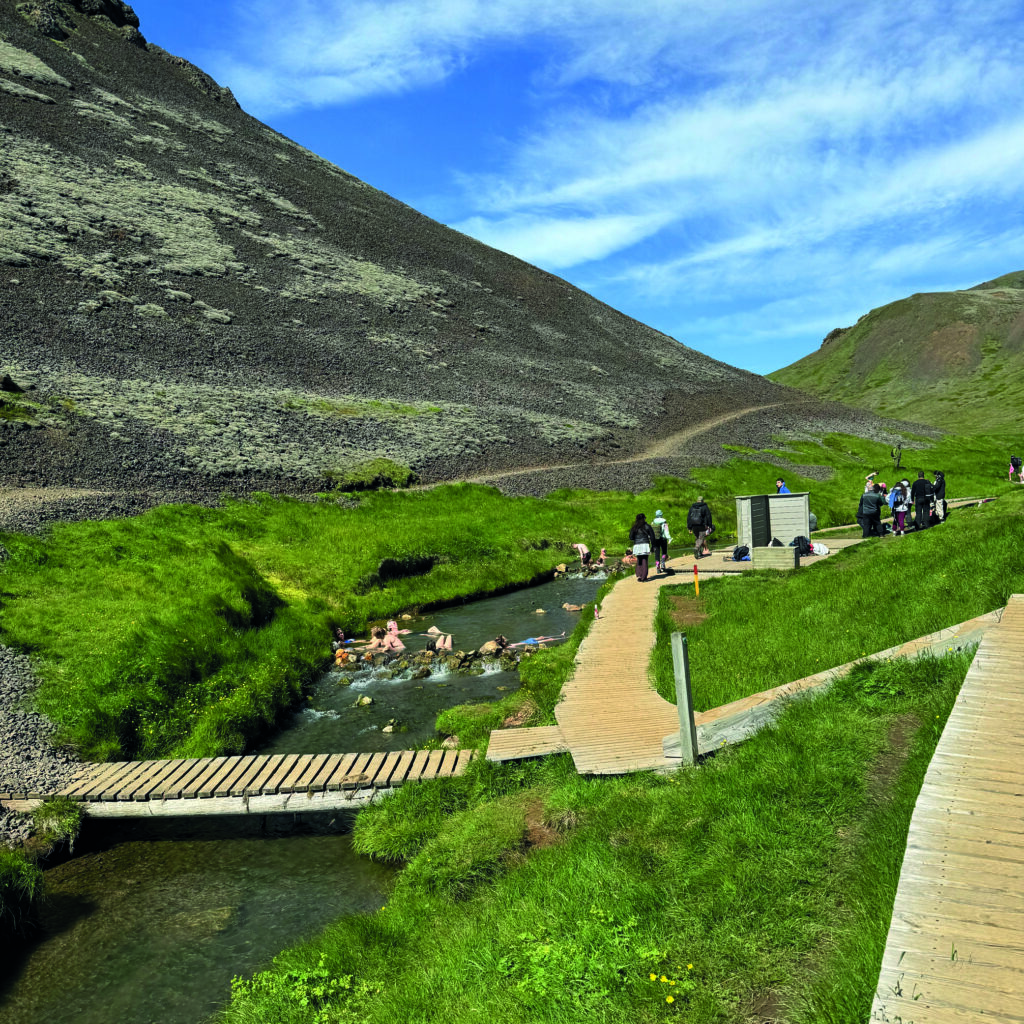
- The water is warmer upstream and cooler downstream — pick your spot!
- The water temperature can vary, but averages around 38-40°C (100-104°F) in bathing spots.
- Minim Visit Duration: 3-4 hours round trip (hike + bathing time)
- Difficulty level: Moderate. The hike is about 3 km one way, with some steep and muddy parts.
- Free entrance. No facilities. No changing rooms. Small parking fee.
- Coffee Shop with facilities in the parking.
Where to Take a Bath around Reykjavik and the Golden Circle?
SOON WE WILL POST A MAP WITH ALL THE PLACES WHERE YOU CAN RELAX AND ENJOY IN THE WATER IN ICELAND.
But meanwhile, here you have a list with some suggestions on the area:
- BLUE LAGOON (Reykjanes Peninsula) 💵💵💵
- LAUGARDALSLAUG SWIMMING POOL (Reykjavik) 💵
- SUNDHÖLL SWIMMING POOL (Reykjavik) 💵
- VESTURBÆJARLAUG SWIMMING POOL (Reykjavik) 💵
- ÁRBÆJARLAUG SWIMMING POOL (Reykjavik) 💵
- KVIKA FOOTBATH (Reykjavik)
- FONTANA GEOTHERMAL BATHS (Laugarvatn) 💵💵
- SECRET LAGOON (Flúðir, Golden Circle) 💵💵
- HRUNALAUG HOT SPRING (Flúðir, Golden) 💵
- REYKJADALUR HOT SPRING RIVER (Hveragerði, Golden)
- LAUGASKARÐ SWIMMING POOL (Hveragerði, Golden) 💵
- SUNDHÖLL (Selfoss) 💵
Discover More About Iceland
Travel Guide to Iceland – Essential Tips for a Perfect Trip
Discover Iceland with your LOÐVINIR Friends!
ICELAND GUIDE: SOUTH EAST (FROM VÍK TO HÖFN)
ICELAND GUIDE: SOUTH (FROM SELFOSS TO VÍK)
Handmade. Natural materials. Hypoallergenic.
Adopt an Icelandic Puffin Plush – The Perfect Souvenir
Soft. Eco-friendly. Designed in Iceland.
Helps support Icelandic wildlife conservation.



